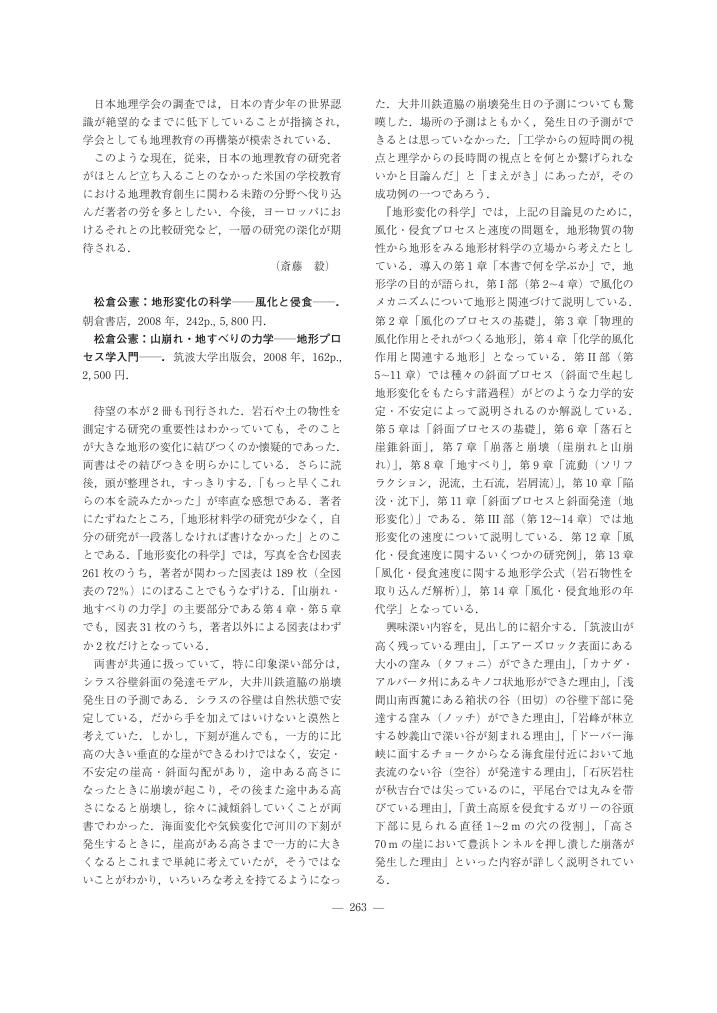3 0 0 0 OA 扇状地データベース
- 著者
- 小口 高 斉藤 享治 原 美登里 門村 浩 林 舟
- 出版者
- 公益社団法人 東京地学協会
- 雑誌
- 地学雑誌 (ISSN:0022135X)
- 巻号頁・発行日
- vol.109, no.1, pp.120-125, 2000-02-25 (Released:2010-10-13)
- 参考文献数
- 18
Data for Japanese alluvial fans have been made available on the Internet using ArcView IMS, a GIS-based map server software package. This system permits easy on-line browsing of the data from anywhere in the world and the creation of thematic maps at various scales for the area around an alluvial fan.
- 著者
- 斉藤 享治
- 出版者
- 公益社団法人 日本地理学会
- 雑誌
- 地理学評論 Series A (ISSN:18834388)
- 巻号頁・発行日
- vol.83, no.5, pp.535-536, 2010-09-01 (Released:2012-01-31)
1 0 0 0 OA 太田陽子・小池一之・鎮西清高・野上道男・町田 洋・松田時彦:日本列島の地形学
- 著者
- 斉藤 享治
- 出版者
- 公益社団法人 日本地理学会
- 雑誌
- 地理学評論 Series A (ISSN:18834388)
- 巻号頁・発行日
- vol.83, no.3, pp.344-346, 2010-05-01 (Released:2012-01-31)
- 参考文献数
- 2
- 著者
- 斉藤 享治
- 出版者
- 公益社団法人 日本地理学会
- 雑誌
- 地理学評論 Series A (ISSN:18834388)
- 巻号頁・発行日
- vol.82, no.3, pp.263-264, 2009-05-01 (Released:2011-08-25)
1 0 0 0 OA 日本第四紀学会・町田洋・岩田修二・小野昭編: 地球史が語る近未来の環境
- 著者
- 斉藤 享治
- 出版者
- The Association of Japanese Geographers
- 雑誌
- 地理学評論 (ISSN:13479555)
- 巻号頁・発行日
- vol.81, no.1, pp.41-42, 2008-01-01 (Released:2010-03-12)
1 0 0 0 OA 集水域の地形・地質条件による扇状地の分類
- 著者
- 斉藤 享治
- 出版者
- The Association of Japanese Geographers
- 雑誌
- 地理学評論 (ISSN:00167444)
- 巻号頁・発行日
- vol.55, no.5, pp.334-349, 1982-05-01 (Released:2008-12-24)
- 参考文献数
- 26
- 被引用文献数
- 1 1
集水域面積100km2, 500km2前後の集水域と,土石流が発生しやすい地質(深成岩,凝灰岩,集塊岩)からなる集水域では,扇状地の形成される集水域の占める割合が大きいことを明らかにした.これらの扇状地が形成されやすい集水域の地形・地質条件を解釈することによって,扇状地堆積物の供給・運搬様式を考察した. 集水域面積200km2以下の集水域では,土石流等によって河床に堆積していた砂礫が,洪水時に一気に谷口まで運搬され,堆積して扇状地を形成する。特に,100km2前後の集水域では,洪水発生頻度が高いので扇状地ができやすい.200km2以上の集水域では,河床堆積物が何回もの洪水によって谷口まで運搬され,掃流砂礫が低地に満遍なく堆積して扇状地を形成する.この場合,集水域が大きすぎても,河床勾配が緩くなり,粗粒の岩屑が運搬されにくい.その結果, 500km2前後の集水域では,扇状地が形成されやすくなったと考えられる. 200km2前後の集水域では,荷重量の相対的に小さい洪水流が発生したときに,谷口に堆積していた岩屑が,侵食・運搬されることもあるので,扇状地ができにくくなったものと思われる.
1 0 0 0 OA 大規模「扇状地」と沖積扇状地の区分-河成扇状地の国際的再確認に向けて-
1 0 0 0 IR コスタリカの扇状地からみた沖積扇状地と巨大扇状地の比較<渋谷治美教授退職記念特集>
- 著者
- 斉藤 享治
- 出版者
- 埼玉大学教育学部
- 雑誌
- 埼玉大学紀要. 教育学部 (ISSN:18815146)
- 巻号頁・発行日
- vol.63, no.1, pp.185-192, 2014
There is a discussion whether megafans are alluvial fans or not. It is difficult to define whether the formation processes of megafans are the same as those of alluvial fans or not, because the surface deposits are sometimes different from the fan deposits. However, strong relationships between drainage basin areas and fan surface areas exist in alluvial fans with the same processes. Kesel (1985a, b) stated that alluvial fans in the General Valley of Costa Rica are larger than many arid fans with comparable drainage basin areas and that the position of the Kosi megafan closely coincides with the trend line of the Costa Rican fans. The statement suggests that the megafan is a member of the alluvial fans. Hence, the relationships between drainage basin areas and fan areas, including the Costa Rican fans are examined in this study. Alluvial fans over 2 km2 in area and steeper than 0.002 in mean fan slope were collected, and the drainage basin and fan areas were measured by use of 1: 50,000 topographic maps. In Costa Rica there are 18 alluvial fans, including four fans in the General Valley. The regression line between drainage basin areas and fan areas is shown by Af = 0.59 Ad0.71, where Af and Ad mean fan area and drainage basin area respectively. The regression line in Costa Rica is similar to those in Japan, Taiwan, the Philippines and New Zealand. For the comparison between alluvial fans and megafans, the Kosi megafan, Okavango fan, and five megafans in the Gran Chaco to the east of the Andes are chosen. The positions of seven megafans are beyond regression lines of five regions, including Costa Rica. Seven points are around regression lines in the San Joaquin Valley by Bull (1964) and in the General Valley by Kesel (1985a). The fan areas by Kesel are overestimated in the General Valley. Therefore, the comparison between drainage basin areas and fan areas in the San Joaquin Valley will be required in future.



